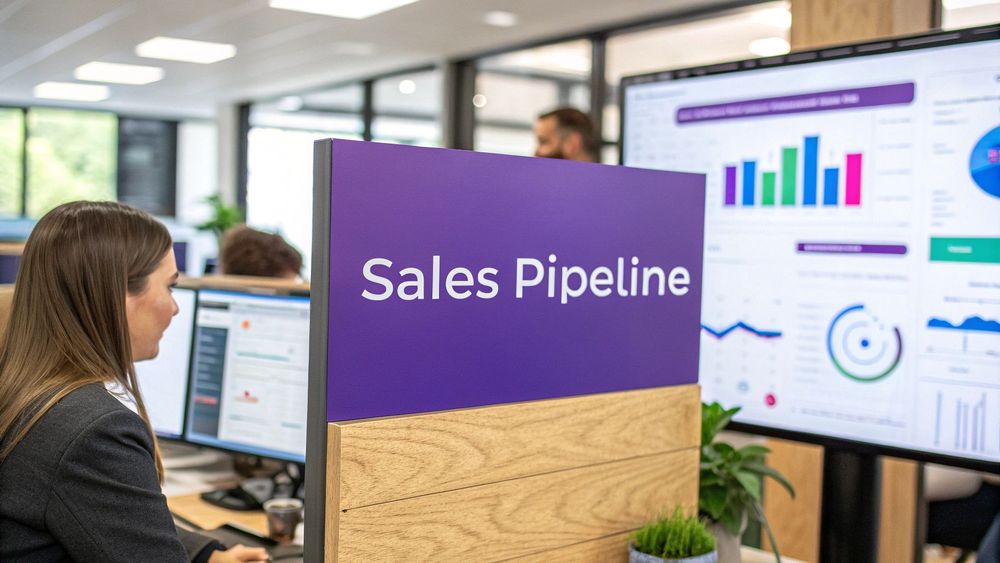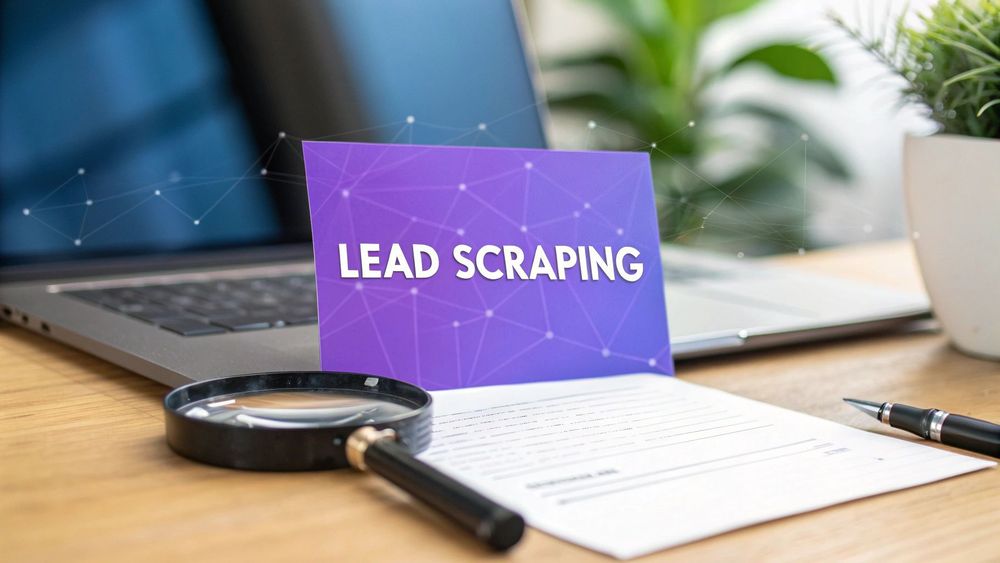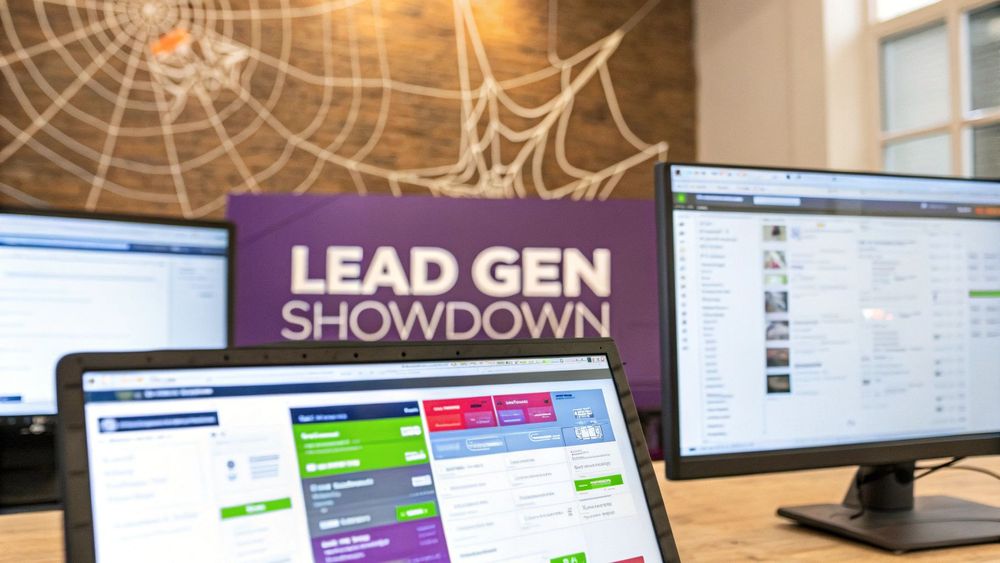Building a solid sales pipeline is all about mapping out the journey a prospect takes from the first "hello" to becoming a happy customer. It starts with figuring out who you're selling to, finding those ideal customers, and then guiding them through each step until the deal is done.
Understanding the Modern Sales Pipeline

Think of your sales pipeline as your revenue roadmap. It’s a visual, systematic way to track the specific actions your team takes to turn curious prospects into loyal customers. It’s your internal playbook for winning deals.
People often mix this up with a sales funnel, but they're fundamentally different. A funnel shows the customer's journey from their point of view—it's a numbers game. You see how 1,000 website visitors become 100 qualified leads, for example. Your pipeline, on the other hand, is all about the active steps your reps are taking to push those deals forward.
The Shift to a Buyer-Centric Model
The modern B2B buyer has completely changed the game. They do a ton of research online before ever wanting to talk to a sales rep. They're informed, they're savvy, and they expect you to understand their world.
This means our old, rigid, seller-focused processes just don't cut it anymore. A modern pipeline has to be dynamic. It needs to reflect how your customers actually buy, not just how you want to sell. While every business is different, the core stages usually look something like this:
- Prospecting: This is where it all begins. You're hunting for potential customers who perfectly match your Ideal Customer Profile (ICP).
- Qualification: Here, you're digging in to see if a prospect has a real need, the budget to solve it, and the authority to make a decision.
- Meeting/Demo: Time to connect. You engage with the prospect, listen to their pain points, and show them exactly how your solution can help.
- Proposal: You've understood their problem and are ready to send a formal offer that spells out the solution, scope, and price.
- Negotiation/Closing: This is the final stretch—ironing out the details and getting the contract signed.
- Closed-Won/Lost: The deal is done. You mark its final outcome and, either way, you learn something for next time.
A pipeline isn't just a dashboard for tracking deals; it's the single most important predictor of future revenue. It provides the clarity needed to forecast performance, prioritize opportunities, and drive predictable growth.
Why a Structured Pipeline Is Non-Negotiable
Without a defined pipeline, your sales efforts are just chaos. You're constantly reacting instead of proactively driving results. With one, you gain control and total visibility.
The numbers back this up. Building a strong sales pipeline is critical to sustained growth, with research showing that companies who manage their sales pipelines effectively achieve a 28% higher revenue growth rate than those who don't. That's a massive difference. This direct link shows how a well-oiled pipeline gives you a clear view of your opportunities and makes your forecasting way more reliable. If you're curious about more trends, the team at SalesIntel has some great insights.
Ultimately, getting this framework right is the first step toward building a pipeline that doesn’t just track your deals but actively helps you win them. It’s about turning sales from an art into a repeatable science.
Laying the Foundation with Your Ideal Customer Profile
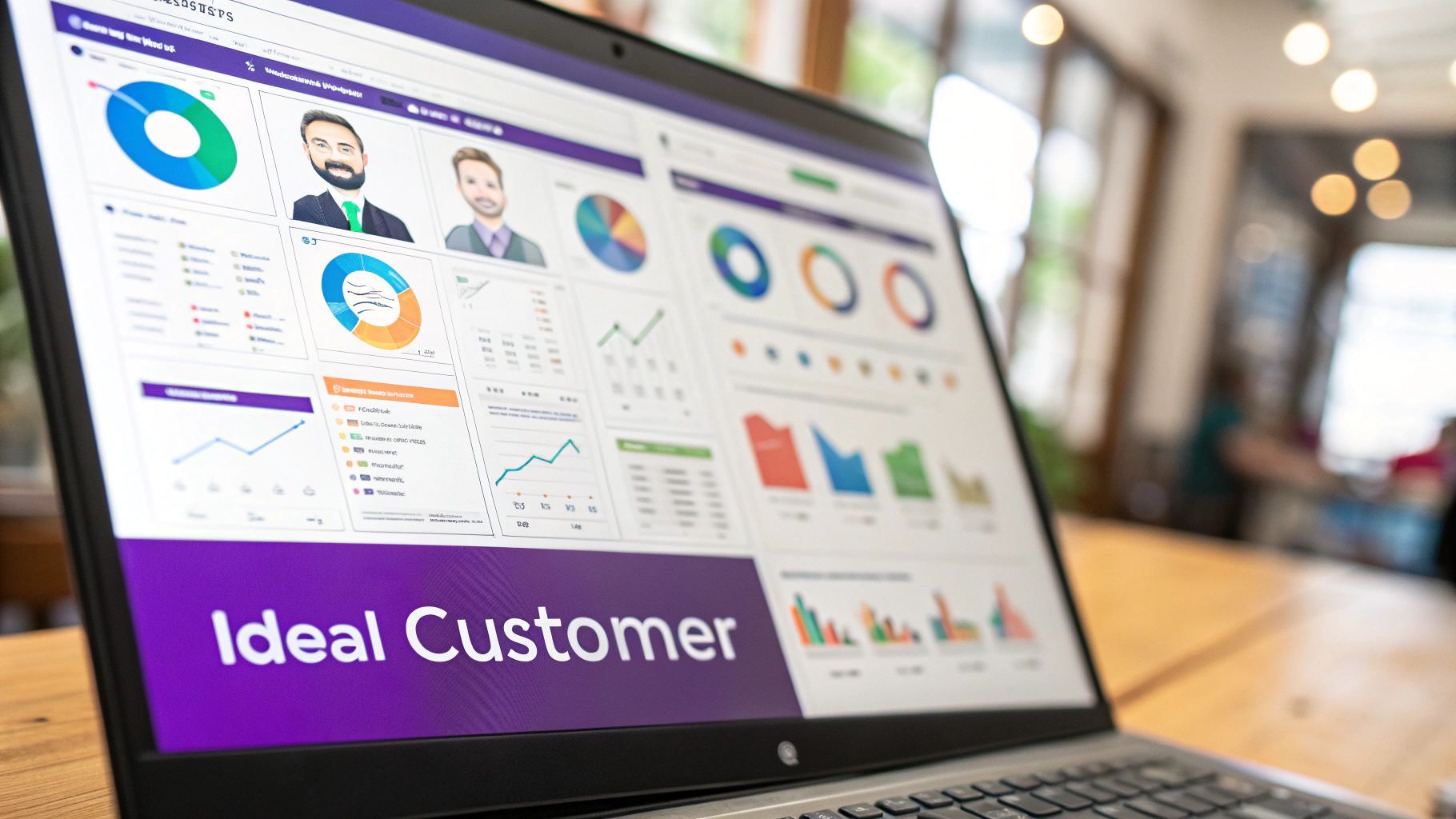
Before you even think about filling your sales pipeline, you have to know exactly who you're building it for. Jumping in without a crystal-clear Ideal Customer Profile (ICP) is like setting sail without a map. Sure, you might get lucky, but you'll burn a ton of time and energy chasing deals that were never going to close.
An ICP isn't just about basic demographics. It's a hyper-detailed portrait of the company that gets the absolute most value from what you sell. Think of it as the DNA of your best customer, capturing all the little traits that scream "perfect fit."
The real goal here is to shift from a vague idea like "we sell to tech companies" to a laser-focused definition: "we sell to Series B SaaS companies with 50-200 employees, using HubSpot, that recently hired a VP of Sales." That level of detail is what transforms your pipeline from a guessing game into a predictable revenue machine.
Pinpointing Your Best Customers
The best way to build your ICP is to look at the customers you already have. Your happiest, most successful clients are your north star. Just analyze who they are and find the common threads.
Firmographics: Start with the company-level basics. What industries do they operate in? What’s their company size, either by employee count or annual revenue? Where are they located?
Technographics: What tools are in their tech stack? Knowing their CRM, marketing automation platform, or cloud provider can be a huge qualifying signal.
Pain Points: Get to the heart of why they bought from you. What specific business problem were they desperate to solve? Forget features for a second and focus on the pain. Were they trying to slash costs, boost efficiency, or break into a new market?
Buying Signals: Look for trigger events. Did they just secure a new round of funding? Hire a key executive? Announce an expansion? These moments often create a perfect window of opportunity.
By weaving these threads together, you create a blueprint for finding more companies just like your best ones. This is the bedrock of effective prospecting and list building—it ensures every lead you chase has real potential right from the start.
Translating Your ICP into Pipeline Stages
With a solid ICP in hand, you can finally design a sales pipeline that actually mirrors how these specific customers buy. Ditch the generic templates. Your pipeline stages should reflect the key milestones in your ideal customer's journey, not some one-size-fits-all model.
For instance, the pipeline for a high-touch professional services firm will look completely different from one for a self-serve SaaS product.
| Business Model | Example Pipeline Stages |
|---|---|
| SaaS (High-Velocity) | Trial Sign-Up → User Activation → Qualified Lead → Demo Booked → Closed-Won |
| Professional Services | Initial Contact → Discovery Call → Scoping Session → Proposal Sent → Contract Negotiation → Closed-Won |
This customization is absolutely critical. It gives your team a clear playbook, showing them exactly what to do at each step to push a deal forward. It also makes your sales forecasting infinitely more accurate because each stage represents a meaningful, tangible step toward closing a deal.
An ICP isn’t a static document you create once and forget about. Think of it as a living guide. As your business grows and you collect more data, you should constantly revisit and sharpen your profile to keep it relevant.
Building your sales pipeline on the solid foundation of a well-defined ICP ensures your team isn't just busy, but productive. It focuses everyone's efforts on the opportunities with the highest chance of closing, which is the most important step in building a pipeline that truly converts. You can dive deeper into these strategies in our guide to effective list building.
Filling Your Pipeline with High-Quality Leads
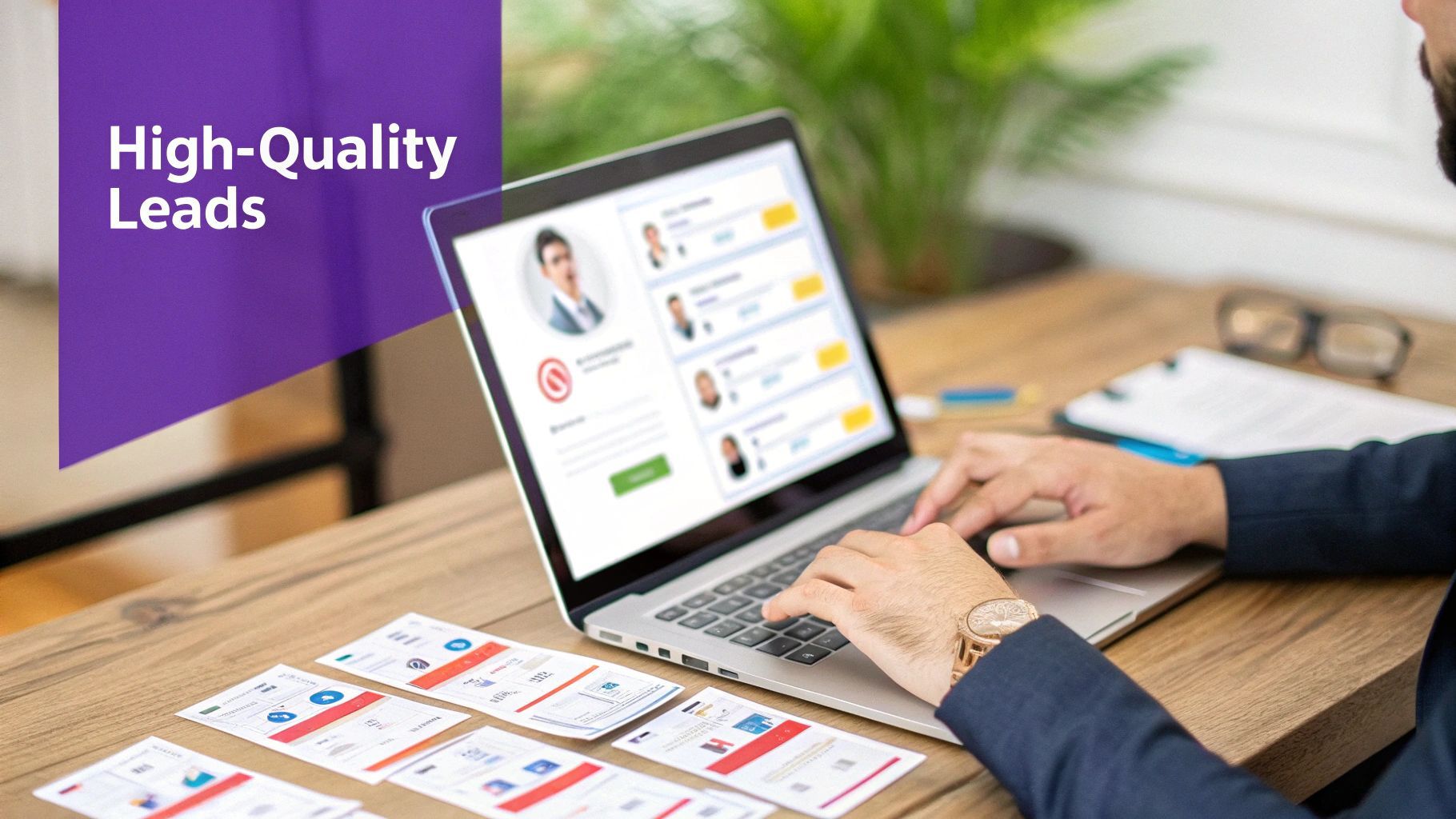
This screenshot highlights the simplicity of ProfileSpider, turning complex data extraction into an effortless one-click action directly within your browser.
So, you’ve hammered out your Ideal Customer Profile (ICP). That's a huge step. But now comes the real grind: finding those exact people and actually getting them into your pipeline.
Let's be honest, a pipeline is only as good as the leads you pour into it. If you're filling the top with low-intent, poorly matched prospects, all you're doing is setting your sales team up for a long, frustrating road to nowhere.
The Old Way: Manual Prospecting Hell
We've all been there. The traditional way of finding leads is a soul-crushing, manual slog. Think endless hours spent scrolling through LinkedIn, meticulously copying and pasting names, titles, and company details into a sprawling spreadsheet. It's not just tedious; it’s a bottleneck that chokes your sales process before it even gets a chance to breathe.
Imagine a sales rep who needs to find 50 new marketing managers at SaaS companies. The old workflow is painful to even think about:
- The Endless Scroll: Burn 1-2 hours on LinkedIn, tinkering with search filters and wading through hundreds of profiles to find the right contacts.
- The Copy-Paste Grind: Open up a spreadsheet and painstakingly type or paste each person's name, title, company, and LinkedIn URL. One. By. One.
- The Email Guessing Game: Now, try to find a valid email. This usually involves clumsy guesswork or bouncing between third-party tools that give you questionable results at best.
- Rinse and Repeat: Do this every single week just to keep the pipeline from completely drying up.
This isn't selling; it's data entry. And every minute spent on this administrative busywork is a minute not spent building relationships and closing deals.
Letting high-value deals stall because of a lack of consistent follow-up is a common pipeline mistake. Research shows it takes more than eight touchpoints to close a deal, yet 44% of salespeople give up after just one. An inefficient prospecting process is often the root cause, as it leaves reps with too little time to nurture the leads they already have.
The Modern Way: One-Click Lead Generation
The modern, no-code alternative is to automate the most draining parts of prospecting. This shift means a constant, predictable flow of high-quality leads into your pipeline. It’s all about working smarter, not just harder.
The new workflow is built for speed and precision. Let's take that same task of finding 50 marketing managers:
- Laser-Focused Search: Run one specific, targeted search on LinkedIn or a niche industry site that instantly surfaces a list of perfect-fit prospects.
- One-Click Extraction: This is the game-changer. Use an AI-powered tool like ProfileSpider to grab all the profile data from that search results page in a single click. Names, titles, contact info, companies—it’s all captured instantly and accurately.
- Instant Organization: The data isn't just extracted; it's automatically structured and saved locally in your browser. From there, you can export a clean, ready-to-use list straight into your CRM or outreach platform.
A task that once burned an entire afternoon is now done in minutes. This speed isn't just a convenience; it's a strategic advantage. It allows you to build much larger, more targeted prospect lists, dramatically increasing the quality and quantity of opportunities at the top of your funnel.
Where to Find High-Quality Leads
Your ICP is your treasure map—it tells you exactly where to dig. While LinkedIn is the default for most B2B sales, don't get tunnel vision. Your ideal customers are congregating in other places, too.
| Lead Source | Why It's Valuable | Best For |
|---|---|---|
| LinkedIn Sales Navigator | Advanced filters let you pinpoint prospects matching your ICP with surgical precision. | B2B teams targeting specific roles, industries, and company sizes. |
| Industry-Specific Forums | Niche communities where professionals are actively discussing their challenges. | Finding highly engaged prospects with clearly defined pain points. |
| Company 'About Us' Pages | A direct line to key decision-makers and a great way to map out an organization. | Account-based marketing (ABM) and targeted outreach to entire teams. |
| Event Attendee Lists | A pre-qualified list of people who have already raised their hands as interested in your space. | Post-event follow-up and building lists around a specific conference theme. |
For sales teams ready to really scale their efforts, diving into AI lead generation opens up even more powerful strategies. The trick is to stop thinking about a single platform and start meeting your prospects where they already are.
When you combine a razor-sharp ICP with efficient extraction tools, you create a powerful engine that consistently fills your sales pipeline with real opportunities—the kind that actually convert.
Using Automation to Scale Your Sales Efforts
So you’ve built your sales pipeline. That’s a great first step, but the real growth engine kicks in when you start scaling it. Think about it: a pipeline packed with leads is pretty much useless if your team is so buried in manual tasks they can't actually follow up and nurture them.
This is exactly where technology comes in. It helps turn a manual, time-sucking headache into an efficient, data-driven system. The whole point is to free up your sales team to do what they do best: sell.
This shift isn't just a nice-to-have anymore. The B2B sales world has changed. The sales automation market is on track to hit $16 billion by 2025, more than doubling from $7.8 billion in 2019. Why? Because a staggering 80% of B2B decision-makers now prefer digital interactions. To keep up with all these moving parts, automation is no longer optional.
The CRM as Your Central Hub
Your Customer Relationship Management (CRM) system is the absolute heart of your sales operation. It’s where every single lead, interaction, and deal lives. Trying to manage complex relationships with spreadsheets and sticky notes is a recipe for disaster—you're just asking for high-value opportunities to slip through the cracks.
A well-oiled CRM lets you:
- Track Every Interaction: Log every call, email, and meeting. This gives you a complete, living history for each prospect.
- Maintain a Single Source of Truth: Everyone on your team sees the same, up-to-date information. No more guessing games.
- Forecast with Accuracy: Use real-time data to predict revenue and spot potential gaps before they become big problems.
From Manual Data Entry to One-Click Integration
Let's be honest, the biggest bottleneck in any sales process is getting good lead data into the CRM. Manually typing in information from LinkedIn or company websites is painfully slow and riddled with human error. This is where the workflow between prospecting and pipeline management has to be airtight.
The old way was just hours of tedious copy-pasting. The modern approach connects these two worlds directly.
This diagram shows you exactly what a modern, automated workflow looks like—from pulling lead info all the way to starting your outreach.
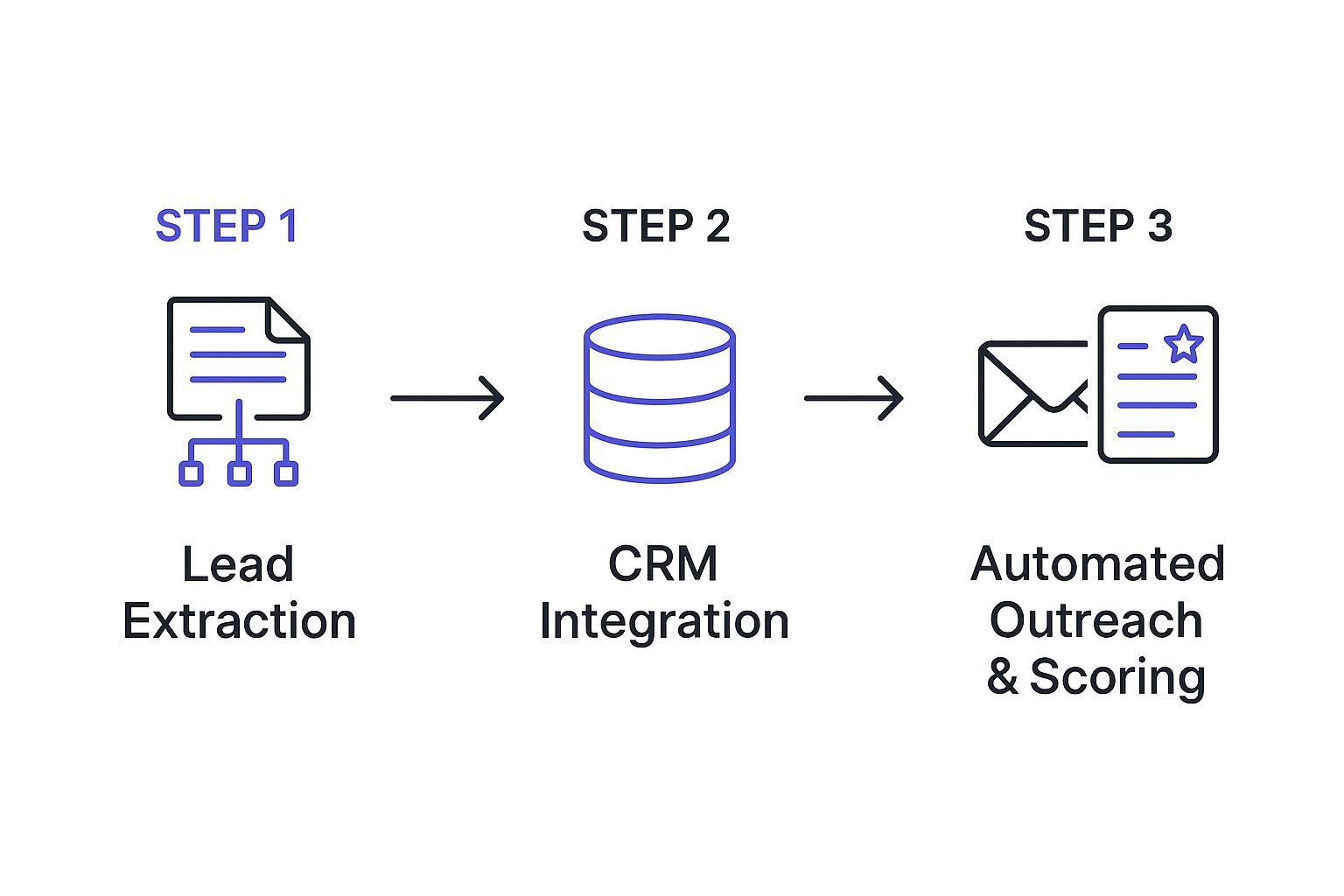
As you can see, a tool like ProfileSpider is the critical first piece of the puzzle. With its one-click profile extraction, you can grab hundreds of targeted leads and push them straight into your CRM. This completely eliminates manual data entry, guarantees accuracy, and lets your automated nurturing sequences kick in right away.
Automating the Repetitive Work
Once those leads are neatly sitting in your CRM, automation can take over all the repetitive, time-sucking tasks—the stuff that's essential but doesn't need a human touch. This is how you can truly multiply your efforts without having to hire an army of reps.
Automation isn't about replacing salespeople; it's about empowering them. By taking over the tedious follow-ups and data management, it frees up reps to focus on high-value conversations, strategic planning, and building genuine relationships with prospects.
Here are a few classic automation workflows you can set up:
- Automated Email Sequences: Trigger personalized follow-up emails the moment a lead moves to a new stage in your pipeline.
- Lead Scoring: Automatically assign points to leads based on things like their company size or how they interact with your content. This helps your reps focus their energy where it counts most.
- Task Reminders: Set up automatic nudges for reps to follow up after a demo or when a deal has gone quiet for too long.
Manual vs Automated Pipeline Building
To really see the difference, it helps to put the old way and the modern way side-by-side. The gap in efficiency becomes pretty clear.
| Pipeline Activity | Manual Method (The Old Way) | Automated Method (The Modern Way) | Key Benefit of Automation |
|---|---|---|---|
| Lead Prospecting | Manually searching LinkedIn/websites, copy-pasting data. | Using a tool like ProfileSpider for one-click data extraction. | Speed: Captures hundreds of leads in minutes, not hours. |
| CRM Data Entry | Typing contact details and company info into the CRM. | Direct export from lead gen tool to CRM (e.g., CSV upload). | Accuracy: Eliminates typos and inconsistent data entry. |
| Initial Outreach | Manually sending individual welcome or follow-up emails. | Automated email sequences triggered by a new CRM entry. | Consistency: Ensures every lead gets a timely, personalized touchpoint. |
| Lead Qualification | Reps manually research and assess each lead's potential. | Automatic lead scoring based on predefined rules (e.g., industry, job title). | Prioritization: Sales team focuses only on the most promising leads. |
| Follow-Up Cadence | Relying on memory or calendar reminders to follow up. | Automated task creation and email sequences for nurturing. | Thoroughness: No lead gets forgotten or falls through the cracks. |
The takeaway is simple: automation handles the grunt work, so your team can focus on building relationships and closing deals.
To really get the most out of your sales efforts and make sure no lead gets left behind, it's worth digging into the benefits of business process automation. By integrating smart tools, you create a powerful, end-to-end workflow that starts with seamless lead extraction and ends with consistent, timely nurturing. If you're ready to put these ideas into practice, our guide on marketing automation workflow examples has some great templates to get you started.
Keeping Your Pipeline Healthy and Productive
Building a sales pipeline isn't a "set it and forget it" kind of deal. Think of it more like tending a garden. You have to constantly water it, pull the weeds, and measure its growth if you want a consistent harvest. Let it go, and it'll quickly get overgrown with dead-end deals and wildly inaccurate forecasts, turning your best asset into a real liability.
The secret to a healthy, productive pipeline? Data. You've got to track the right things to understand its rhythm and see where deals are flowing smoothly—and where they're getting stuck. This moves you from simply guessing what's going on to knowing exactly where to focus your energy for the biggest impact.
Key Metrics for Pipeline Health
To get a real feel for your pipeline's health, you need to look beyond just the total number of deals. A few key performance indicators (KPIs) give you the full story, telling you not just what's happening, but why.
- Pipeline Velocity: This is your pipeline's ultimate health score. It tells you how fast deals are moving from the first touch to closed-won. The faster your velocity, the more efficient your sales process is. Simple as that.
- Stage-by-Stage Conversion Rates: This is where you find the leaks. If you're converting tons of leads from 'Qualification' to 'Demo' but they're falling off a cliff before the 'Proposal' stage, you've just found a massive bottleneck to investigate.
- Average Deal Size: Are you closing a few huge wins or a hundred tiny ones? Tracking this helps you understand the quality of your leads and makes sure the team is chasing opportunities that actually move the needle on revenue goals.
- Sales Cycle Length: On average, how long does it take to close a deal? If this number starts creeping up, it’s an early warning that something's creating friction—maybe a market shift, a process problem, or an issue with your value prop.
Keeping an eye on these core metrics turns your pipeline from a simple list of deals into a powerful diagnostic tool.
From Data to Actionable Insights
Collecting data is the easy part. The real magic happens when you turn those numbers into strategic actions that actually improve performance.
Daily pipeline management is what builds and keeps momentum. Tracking simple activities—like how many sales qualified leads (SQLs) you added or how many follow-ups went out—ensures your pipeline never goes stale. For instance, data from a HubSpot report shows that companies responding to leads within an hour are nearly seven times more likely to close those deals. Speed in the early stages matters. A lot.
Let’s make this real. Imagine your data shows a dismal conversion rate between the 'Proposal' and 'Closed-Won' stages. That's not just a number; it's a signal. It could mean a few different things:
- Your pricing is off.
- Your proposals aren't clearly showing the value.
- Your team is struggling to handle objections.
Armed with that insight, you can take specific actions. Maybe you refine your proposal template, get your team some better negotiation training, or take another look at your pricing. This is how you systematically plug the leaks and fine-tune your entire process. For a deeper dive, check out these expert tips on managing your entire sales pipeline.
A healthy pipeline isn't just full; it's fluid. Stalled deals and outdated information clog your forecast and waste valuable selling time. Regularly cleaning out dead-end opportunities is just as important as adding new ones.
At the end of the day, a productive pipeline is a direct reflection of a well-defined and constantly improving process. When you treat it like a living system and use data to guide your decisions, you create a predictable and scalable engine for growth.
Common Questions About Building a Sales Pipeline
Even with a solid plan, you're going to have questions. Everyone does. Building and managing a sales pipeline isn't a "set it and forget it" kind of thing, and a lot of challenges pop up along the way.
Think of this as your go-to guide for the most common sticking points sales pros run into. Getting these answers right is what helps you turn theory into action and keep your pipeline humming.
How Many Stages Should My Sales Pipeline Have?
There’s no magic number here, but the sweet spot for most businesses is somewhere between 5 and 7 stages. What really matters is creating a structure that mirrors how your customers actually buy from you, not just how you want to sell to them.
A pretty standard setup might look something like Prospecting, Qualification, Meeting/Demo, Proposal, Negotiation, and Closed. The goal is to find the right balance.
- Too few stages? You'll lose crucial details. It becomes almost impossible to figure out where deals are getting stuck.
- Too many stages? You'll create a monster. Your reps will spend more time managing the pipeline than selling, and consistency goes out the window.
My advice? Start with the absolute core milestones every deal has to hit. You can always tweak it later once you have some data to back up your decisions.
What Is the Difference Between a Sales Pipeline and a Sales Funnel?
This one trips people up all the time, but the distinction is actually super important for thinking clearly about your strategy. They’re two sides of the same coin, offering different perspectives on the customer journey.
A sales pipeline is all about the seller's actions. It’s a map of the specific steps your team takes to push an opportunity from lead to closed deal.
A sales funnel, on the other hand, is about the buyer's journey. It shows the volume of prospects as they move from awareness to consideration, highlighting conversion rates at a high level.
Think of it this way: your pipeline tells you a deal is in the "Proposal Sent" stage. Your funnel shows that of the 1,000 people who saw your ad, only 100 became qualified leads. One is about managing deals, the other is about understanding customer volume and flow.
How Often Should I Review My Sales Pipeline?
Pipeline reviews need to become a disciplined habit, not just something you do when things feel slow. The right cadence really depends on who's doing the looking.
Daily (For Reps): Every single sales rep should be living in their pipeline daily. It’s their command center. It’s where they plan their day, prioritize follow-ups, and keep their deals inching toward the finish line.
Weekly (For Managers): As a manager, you need to be holding a formal pipeline review with your team at least once a week. This is your time to coach, spot at-risk deals, and make sure the team’s forecast is actually based in reality.
Monthly/Quarterly (For Leadership): The big-picture, strategic review should happen every month or quarter. This is where you zoom out, see how the pipeline is tracking against business goals, and identify broader trends that might require a strategy shift.
How Do I Start Building a Pipeline from Scratch?
Staring at a blank slate is daunting. I get it. The key is to forget about perfection and just focus on getting the engine started. You can build momentum surprisingly fast.
Define Your Ideal Customer Profile (ICP): Seriously, don't do anything else until this is done. If you don't know exactly who you're selling to, you're just guessing. Who are the customers that get the most value and are the easiest to work with? Start there.
Map a Simple Process: Just sketch out a basic, 4-5 stage process. Keep it simple. You can add more detail and nuance once you actually have some deals flowing through it.
Generate an Initial Prospect List: This is where you can get a massive head start. Instead of manually scraping LinkedIn for days, use a modern no-code tool like ProfileSpider. You can build a targeted list of 50-100 prospects who fit your ICP in minutes. Its one-click AI extraction pulls complete profiles right into an organized list, saving you a ton of time.
Start Working the Leads: Get those first prospects loaded into your brand-new pipeline stages and start your outreach. The most important step is simply to start. You’ll learn more from working the first ten deals than you will from a week of planning. Adapt and refine as you go.

